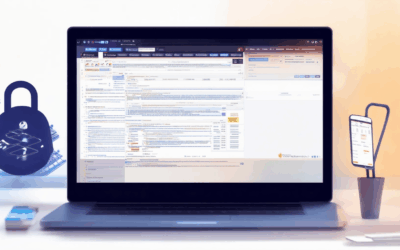In today’s digital age, securing your data has become more crucial than ever. With cyber threats looming large, individuals and businesses alike are constantly seeking effective ways to safeguard their information. Whether it’s protecting personal accounts, sensitive business data, or ensuring privacy online, the need for robust security measures has never been more pressing. This article delves into the essential strategies and tools designed to enhance online data security, offering insights, examples, and actionable steps to help you stay protected in an increasingly connected world.
Key Takeaways
– Encryption: Protect data at rest and in transit using strong encryption algorithms to safeguard sensitive information.
– Access Control: Restrict data access to authorized personnel through multi-factor authentication and role-based access policies.
– Data Anonymization: Use techniques like k-anonymity to mask sensitive information and reduce re-identification risks.
– Regular Audits and Monitoring: Periodically review access logs and systems to identify and address vulnerabilities promptly.
– Employee Training: Conduct security awareness programs to educate staff on best practices, such as recognizing phishing attempts and using strong passwords.
– Third-Party Vendor Management: Ensure vendors comply with security standards and establish strict contractual obligations for data protection.
– Disaster Recovery Planning: Develop and regularly test backup and recovery procedures to minimize data breach impacts.
– Multi-Factor Authentication (MFA): Enhance account security by adding an extra layer of protection beyond traditional passwords.
– Software Updates: Keep applications and systems updated to patch vulnerabilities and stay protected against known threats.
– Network Security: Use strong Wi-Fi passwords and enable WPA3 encryption to secure wireless connections.
– Security Audits: Conduct regular checks to identify vulnerabilities and ensure compliance with regulations like GDPR or PCI-DSS.
– Phishing Training: Stay vigilant against phishing by learning to recognize suspicious communications.
– Behavioral Awareness: Educate yourself and your team about the latest cyber threats through newsletters or security updates.
– Organizational Framework: Develop security policies, prepare incident response plans, and manage third-party vendors effectively.

How to Enhance Data Security
Securing your data is crucial in today’s digital age. Here are proven strategies to safeguard your information effectively:
- 1. Implement Strong Encryption
- Encrypt sensitive data at rest and in transit to prevent unauthorized access.
- Use industry-standard encryption algorithms like AES-256 for data storage and TLS for data transmission.
- Explore encryption tools to streamline secure data handling.
- 2. Adopt Multi-Factor Authentication (MFA)
- Protect accounts with MFA to reduce the risk of password-based breaches.
- Enable MFA for critical systems to add an extra layer of security.
- Discover MFA solutions tailored for your needs.
- 3. Regularly Update Software and Systems
- Keep software, applications, and operating systems up-to-date to patch vulnerabilities.
- Install security patches promptly to defend against known exploits.
- Find resources for updating systems securely .
- 4. Limit Data Access
- Minimize data collection and retention to reduce potential exposure.
- Implement role-based access control to limit data access to authorized personnel only.
- Learn more about data minimization practices .
- 5. Train Employees and Users
- Conduct regular cybersecurity awareness training to educate employees on threats and prevention measures.
- Institute phishing simulations to test and improve security awareness levels.
- Access training programs for your team.
- 6. Implement Zero Trust Architecture
- Adopt a Zero Trust model to verify every access request, regardless of location or device.
- Use identity verification processes to ensure only authorized users gain access.
- Explore Zero Trust solutions .
- 7. Monitor and Log Activity
- Deploy monitoring tools to track and analyze network traffic for suspicious activities.
- Log access attempts and unusual behavior to identify potential breaches early.
- Find monitoring solutions .
- 8. Develop Incident Response Plan
- Create a detailed incident response plan to address data breaches effectively.
- Regularly test the plan through simulations to ensure readiness.
- Review incident response templates .
- 9. Secure Physical Environments
- Control physical access to servers and data centers.
- Use biometric locks and surveillance systems to monitor entry points.
- Explore physical security measures .
- 10. Manage Third-Party Risks
- Conduct thorough background checks on third-party vendors.
- Require strict confidentiality agreements and data protection clauses.
- Manage third-party relationships safely .
Improving Your Online Security: A Comprehensive Guide
Securing your online presence is crucial in today’s digital age. Here’s a structured approach to enhance your cybersecurity:
1. Create Strong Passwords
- Use a combination of uppercase and lowercase letters.
- Incorporate numbers and special characters ($, %, etc.).
- Aim for at least 12-16 characters per password.
- Never reuse passwords across multiple accounts.
- Consider using a password manager for easier management.
2. Enable Two-Factor Authentication (2FA)
- Protect your accounts with an extra layer of security.
- Use authenticator apps or SMS codes for verification.
- Enable 2FA for all critical accounts, including email and banking.
3. Secure Your Wi-Fi Connection
- Avoid using public Wi-Fi for sensitive activities.
- Check for the HTTPS padlock icon before entering personal info.
- Use a VPN for added protection when connecting to public networks.
4. Regular Software Updates
- Keep your devices updated to patch security vulnerabilities.
- Enable automatic updates for OS and applications.
- Scan for updates regularly to ensure protection.
5. Spot Phishing Attempts
- Look for unusual links or requests in emails.
- Verify the sender’s identity before clicking links.
- Be cautious with unsolicited emails or messages.
6. Implement Firewall and Antivirus Software
- Install reputable firewall and antivirus programs.
- Run regular scans to detect and remove threats.
- Set up automatic scanning schedules for convenience.
7. Encrypt Files and Messages
- Encrypt sensitive files stored on cloud services.
- Use end-to-end encryption for messaging apps.
- Enable encryption settings in your cloud accounts.
8. Protect Yourself on the Dark Web
- Use specialized browsers for dark web access.
- Stick to well-known, reputable platforms.
- Exercise caution and avoid sharing personal info.
9. Stay Informed About Cyber Threats
- Follow cybersecurity news and updates.
- Engage with online communities for insights.
- Stay ahead of common threats and scams.
10. Utilize Security Tools and Guidelines
- Take advantage of free security tools available online.
- Refer to official cybersecurity guides for best practices.
- Seek assistance from IT professionals if needed.
By following these steps, you can significantly enhance your online security and protect yourself against potential threats. Stay vigilant and adapt to new cybersecurity challenges as they emerge.

How to Enhance Internet Security
To improve your online security, follow these essential steps:
- Enable Strong Authentication : Use multi-factor authentication (MFA) for all accounts. This adds an extra layer of protection beyond just a password.
- Update Software Regularly : Keep all software applications, including operating systems and browsers, up to date. Manufacturers often patch vulnerabilities that hackers exploit.
- Use a VPN : A Virtual Private Network (VPN) encrypts your internet connection, making it harder for attackers to intercept your data. Choose a reputable provider like BlindBrowser for added privacy.
- Secure Wi-Fi Connections : Always use WPA3 encryption for home and public Wi-Fi networks. Avoid using unsecured networks to prevent unauthorized access.
- Limit Device Access : Restrict physical access to your devices and use screen locks. This prevents others from accessing your personal information without your consent.
- Backup Data Regularly : Create regular backups of important files to restore them in case of data loss due to malware or hardware failure.
- Avoid Suspicious Links : Hover over links to check their validity before clicking. Phishing attempts often come via malicious links.
- Use Antivirus Software : Install and regularly update antivirus programs to detect and remove harmful software.
- Educate Yourself : Stay informed about the latest cybersecurity threats and learn how to protect yourself. Platforms like BlindBrowser offer valuable resources and guides.
- Monitor Accounts : Set up alerts for suspicious activities, such as unexpected login attempts or changes to your account settings.
By following these practices, you can significantly enhance your internet security and safeguard your personal information.
For more insights, visit our dedicated security resource hub at [BlindBrowser](https://blindbrowser.com/SecurityHub).

Improving Data Security
To enhance data security, follow these essential steps:
- Encrypt Data:** Protect data at rest and in transit by using strong encryption algorithms. Ensure sensitive information is encrypted before storage and during transmission.
- Implement Access Control:** Restrict data access to authorized personnel using multi-factor authentication, role-based access, and the principle of least privilege.
- Anonymize Data:** Use techniques like k-anonymity or differential privacy to mask sensitive information, reducing the risk of re-identification.
- Audit and Monitor:** Regularly review access logs, system configurations, and data usage patterns to identify and mitigate vulnerabilities.
- Train Employees:** Conduct regular security awareness training to educate staff on best practices, such as avoiding phishing, using strong passwords, and reporting suspicious activity.
- Vet Third-Party Vendors:** Ensure third parties handling your data comply with security standards and establish strict contractual obligations for data protection.
- Develop Disaster Recovery Plans:** Create and regularly test backup and recovery procedures to minimize impact from data breaches or system failures.
What Are 5 Ways to Secure Data?
- 1. Encryption: Convert data into a coded format to prevent unauthorized access. This includes both data at rest and in transit.
- 2. Access Control: Restrict data access to authorized individuals using role-based access policies to minimize exposure risks.
- 3. Data Anonymization: Remove personally identifiable information (PII) from datasets to protect individual privacy while allowing analysis.
- 4. Regular Audits and Monitoring: Periodically review access logs and systems to identify vulnerabilities and potential breaches promptly.
- 5. Training and Awareness: Educate employees on security protocols to reduce the risk of accidental data exposure through human error.

Improving Cyber Security
Cybersecurity is a critical aspect of protecting sensitive information and ensuring the safety of your digital assets. Here are some effective strategies to enhance your cybersecurity measures:
1. Implement Strong Passwords
Use complex passwords with a combination of letters, numbers, and symbols. Avoid reusing passwords across multiple accounts. Consider using a password manager to store and organize your credentials securely.
2. Regular Software Updates
Keep your software applications, operating systems, and hardware up to date. Manufacturers regularly release updates to patch vulnerabilities that could be exploited by hackers.
3. Enable Multi-Factor Authentication (MFA)
Protect your accounts with MFA, which adds an extra layer of security beyond just a password. This significantly reduces the risk of unauthorized access, even if someone knows your password.
Additional Tips for Enhanced Protection
- Encrypt Data: Encrypt sensitive information stored on devices and cloud storage to prevent unauthorized access.
- Use Firewalls and Antivirus Software: Install and regularly update firewall and antivirus software to block malicious activities and detect threats.
- Secure Your Network: Use strong Wi-Fi passwords and enable WPA3 encryption for wireless networks to safeguard against eavesdropping.
- Regular Security Audits: Conduct periodic checks to identify vulnerabilities and ensure compliance with security standards like GDPR or PCI-DSS.
- Phishing Training: Stay vigilant against phishing attempts by learning to recognize suspicious emails, messages, and websites.
- Behavioral Awareness: Educate yourself and your team about the latest cyber threats and stay informed through newsletters or security update feeds.
Organizational Cybersecurity Measures
For businesses, implementing a robust cybersecurity framework involves several key steps:
- Develop a Security Policy: Establish guidelines for password usage, data backup, and access control to maintain consistency across the organization.
- Regular Security Audits: Schedule routine audits to identify and fix security gaps before they can be exploited.
- Incident Response Plan: Prepare a plan to respond to and mitigate cyberattacks, minimizing downtime and financial loss.
- Third-Party Vendor Management: Ensure third-party vendors comply with your security policies and conduct background checks on their employees.
Stay Informed and Proactive
Continuous learning and adaptation are vital in the ever-evolving world of cybersecurity. Monitor threat landscapes and adapt your strategies to counter emerging risks. Consider subscribing to security newsletters or joining online forums to stay updated.
Conclusion
By adopting these practices, you can significantly reduce the risk of cyber threats and ensure the protection of your personal and organizational data. Remember, cybersecurity is a shared responsibility, and staying proactive can make a huge difference in safeguarding your digital presence.




